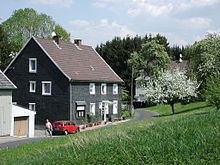Großhülsberg
|
Großhülsberg district of Remscheid |
|
|---|---|
| Coordinates | 51 ° 13 '19 " N , 7 ° 13' 45" E |
| height | 279 m |
| surface | 2.02 km² |
| Residents | 1289 (2013) |
| Population density | 638 inhabitants / km² |
| Post Code | 42899 |
| prefix | 02191 |
| Borough | Luettringhausen |
| Transport links | |
| Federal road |
|
| bus | 666 |
Großhülsberg is a district of the Bergisch city of Remscheid in North Rhine-Westphalia that emerged from an old court . An extensive industrial area around the old settlement core was named after the court.
Location and description
The village is located in the north of the Lüttringhausen district between the Klausen multi-family housing estate and the city limits of Wuppertal - Ronsdorf . The original core of the settlement consists of only about half a dozen residential buildings, most of which are slated half-timbered houses .
Since the 1970s, an extensive industrial park has developed around it that bears the same name. One of the source brooks of the Klausener Bach , a left tributary of the Leyerbach , which in turn flows into the Morsbach , has its source near the village. To the north, the Wuppertal-Oberbarmen – Solingen railway line circles the industrial area in a long arc, while the L58 state road (formerly federal road 51 ) and federal motorway 1 run to the east .
history
In 1471 a Hülsberg was first mentioned in a different spelling. In the early modern era, the court belonged to the Erbschlö Honschaft in the Bergisch Amt of Beyenburg . A daughter farm was split up by the 18th century , because around 1710 the two settlements on Hulßberg with 3 houses and Hillger's Hulßberg with 4 houses are mentioned. The name arose because a lot of sleeves (sleeve mandrels ) used to grow here.
In the Topographia Ducatus Montani by Erich Philipp Ploennies from 1715, a B. Hülsberg (Großhülsberg) and a H. Hülsberg (apparently Hillgers Hülsberg = Kleinhülsberg) are drawn. The former location of Kleinhülsberg, which was a few hundred meters south of the Klausen Bach, has not existed since the 1960s and was built over by multi-family houses from the Klausen settlement.
Business
The directly adjacent industrial area Großhülsberg was skilfully laid out for the old court without significant restrictions . On 54 hectares (2017) there are a total of 90 companies with only a few living spaces. Since 2017, the industrial area has been included in sustainable planning together with industrial areas in Marl and Frankfurt as part of the federally funded project "Green instead of gray" . "Industrial areas in transition" is the motto here and the majority of the entrepreneurs there have a positive view of the research project in cooperation with universities because those responsible expect some improvements for companies and employees. "Sustainability as a success factor in the company" is now the aim.
Individual evidence
- ^ Klaus-Günther Conrads, Günter Konrad: Ronsdorfer Heimat- und Bürgererverein | from 1246 to 1699. In: ronsdorfer-buergerverein.de. www.ronsdorfer-buergerverein.de, accessed on February 1, 2016 .
- ^ Klaus-Günther Conrads, Günter Konrad: Ronsdorfer Heimat- und Bürgererverein | from 1875 to 1899. In: ronsdorfer-buergerverein.de. www.ronsdorfer-buergerverein.de, accessed on February 1, 2016 .


